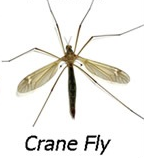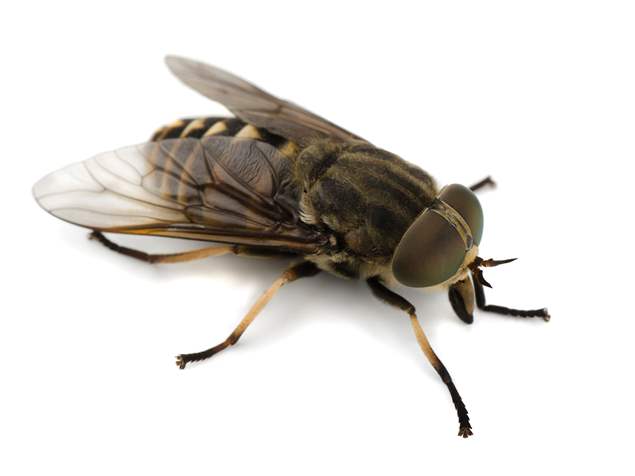
FLY CONTROL
Common Types of Flies
One of the first and most important things to do when treating for flies is identifying which type of fly has infested your home or garden. There are over 120,000 different types of flies! Here are some of the most common types that are likely to be in or around your home. Knowing which fly you have in your home makes it easier to treat.. Once you have identified the type of fly you have, you can move to the next stage – removing potential breeding grounds and making and setting traps to get rid of flies.
Arkansas Flies
House Fly
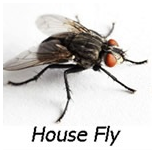
Identification:
Color: commonly grey, black or brown.
Size: 1/4″ in length
Food: Mainly feed on plants, but are omnivorous
Habitat: They lay eggs anywhere from compost and trashcans, to human or animal feces.
Prevention:
- Sanitation is the first measure of defense, even though there are various traps and sprays that are used to kill flies, it is necessary to eliminate the source in order to eliminate them.
- Whenever possible, food and materials on which the flies can lay their eggs must be removed or destroyed, which will isolate the egg-laying adult. Killing adult flies will reduce infestation, but elimination of breeding areas is necessary for good House Fly control management.
- Garbage cans and dumpsters should have tight-fitting lids and be cleaned regularly.
- Drainage will often aid control, getting rid of extra moisture.
- Openings of buildings should be tightly screened with screen.
Fruit Fly
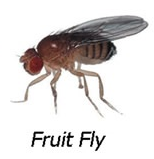
Identification:
Color: Colors range from red to black
Size: 1/16″ in length
Food: They love overripe, ripe, rotten fruits and vegetables.
Habitat: A common fruit fly habitat includes homes, grocery stores, restaurants and anywhere else that food may be rotting and fermenting. Most noticeable summer through fall, fruit flies can be a nuisance year round.
Prevention:
- Keep trash in a receptacle with a tight-fitting lid
- Clean trash receptacles
- Promptly dispose of rotting produce.
- Store edible produce in plastic containers.
- Clean food spills or messes that were found during the inspection.
- Clean under floor mats or rugs.
Blow Fly(Bluebottles)
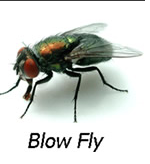
Identification:
Color: : Metallic green or blue.
Size: In terms of fly size, they are on the medium to large side of the scale
Food: They are attracted to dead animal carcasses and animal feces.
Habitat: A common fruit fly habitat includes homes, grocery stores, restaurants and anywhere else that food may be rotting and fermenting. Most noticeable summer through fall, fruit flies can be a nuisance year round.
Prevention:
- Proper sanitation measures must be taken with dumpsters and rodent control measures.
- Exclude Blow/Bottle Flies from a structure with proper screening and maintenance of doors and windows.
- Garbage cans and dumpsters should have tight-fitting lids and be cleaned regularly.
- Drainage will often aid control, getting rid of extra moisture.
- Openings of buildings should be tightly screened.
Cluster Fly
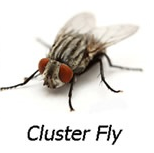
Identification:
Color: : small stripes just behind their head, and grey and black patterns on their abdomens
Size: In terms of fly size, they are on the medium to large side of the scale
Food: they show no interest in human food which lowers the health risks against humans.
Habitat: like to set up shop in your house, and once they do, they can be difficult to eradicate.
Prevention:
- Read and follow directions and safety precautions on labels.
- Handle carefully and store in original labeled containers out of the reach of children, pets, and livestock.
- Dispose of empty containers right away, in a safe manner and place. Do not contaminate forage, streams, or ponds.
Drain Fly

Identification:
Color: : Hairy with small abdomens, large antennae, and leaf shaped wings
Size: In terms of fly size, they are on the medium to large side of the scale
Food: Damp organic material, drains, rotting fruits and vegetables and garbage.
Habitat: These are small flies that are attracted to your bathroom and kitchen. They lay eggs in any decaying matter within a water source such as a blocked drain or plug hole.
Prevention:
- Place some tape over the top of drain, with some holes in it for air flow. If the drain flies get stuck on the tape as they exit the drain, you know you have drain flies.
- Sometimes, drain flies (moth flies) can come from under slab floors from a drain pipe that has broken. They would breed in the organic debis under the slab. Adult flies then enter the living space above the slab through cracks in the slab and back through the drain pipe. To determine if they are coming up through the slab, place the masking tape over the crack as described above.
- If the suspicion is strong enough that drain flies are breeding under a slab, a hole must be broken through the slab to see if indeed a pipe has broken and flies are breeding there. After a hole is broken through the slab, dig in the soil under the slab and inspect. The organic debris and moist soil may actually be several inches under the surface. The presence of fly larvae and/or adults confirms the site as a breeding source.
- Remove all organic debris trapped in small cracks and crevices under the legs and bottom edges of kitchen equipment. The debris needs to removed, thoroughly dried and a long lasting caulk applied to seal the crack.
- If you strongly believe that the shower is a source, it may be necessary to drill a hole into the area under the shower pan or the wall behind the shower. In most cases where moth flies are breeding in this area, adult flies will begin emerging from the hole within minutes. Drain flies are strongly attracted to light and will fly to the hole drilled through the wall.
Flesh Fly
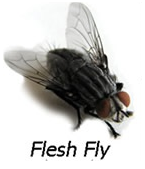
Identification:
Color: : Normally brown, white or black
Size: Flesh flies grow up to almost 3\4″ as adults
Food: Similar to blow flies, flesh flies are attracted to dead animal bodies and animal feces.
Habitat: Most flesh flies breed in carrion, dung, or decaying material, but a few species lay their eggs in the open wounds of mammals; hence their common name. Some flesh fly larvae are internal parasites of other insects. These larvae, commonly known as maggots, live for about 5-10 days, before descending into the soil and maturing into adulthood. At that stage, they live for 5-7 days.
Prevention:
- Using chemical products to treat fly resting places, using chemical fly baits and using aerosol products.
- Using specific approaches to control flies that are inside a home or business. This occurs when flesh flies have developed in the carcass of a dead rodent, bat, bird or other animal that is located above the ceiling, in a wall void or some other hidden, out-of-the-way place. Your pest management professional may suspect flesh flies are developing in a carcass if he finds a large number of flies inside a building. If the source is found, your pest management professional may use chemical control products in the infested area or may need to use light traps to capture adult flies that have emerged
 Little Rock, AR 501-868-3837 | Russellville, AR 479-968-4777 | Hot Springs, AR 501-442-5653 | Fayetteville, AR 479-899-6874
Little Rock, AR 501-868-3837 | Russellville, AR 479-968-4777 | Hot Springs, AR 501-442-5653 | Fayetteville, AR 479-899-6874




